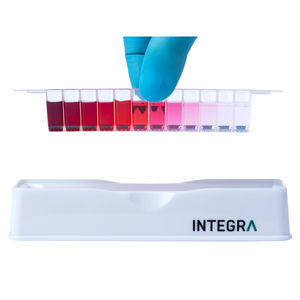
- Products
- Reagent reservoir
- Integra Biosciences AG
- Products
- Catalogs
- News & Trends
- Exhibitions
Reagent reservoir Divided

Add to favorites
Compare this product
Characteristics
- Options
- reagent
Description
Save On Precious Samples And Expensive Reagents!
Large reagent dead volume is a serious issue in laboratories, especially when pipetting precious liquids into well plates using a multichannel pipette. Traditional reservoirs have a V-shaped bottom to minimize dead volumes. However, as the liquid level lowers, the liquid pulls apart and starts to pool. As a result one or several tips on a multichannel pipette may aspirate air. The remaining liquid in the reservoir and the pipette tips is then considered dead volume.
To solve this, INTEGRA developed reservoirs with a SureFlo™ anti-sealing array on the bottom and a unique surface treatment. The anti-sealing pattern consists of a series of tiny channels that allow the liquid to flow evenly across the bottom of the reservoir and prevent pipette tips from sealing. Pooling of liquid is prevented by a specially formulated, hydrophilic surface treatment. Additionally, the reservoir is divided, offering 5 and 10 ml volume side by side, resulting in a reservoir with the lowest possible dead volume!
How it works
25 ml divided reservoirs are comprised of 5 and 10 ml compartments, while still nesting comfortably in the standard 25 ml reusable, sturdy base. Each reservoir features the SureFlo™ anti-sealing array and hydrophilic surface treatment providing especially low dead volumes. This is particularly helpful when pipetting precious samples or expensive reagents with a multichannel pipette. Inserts are available in polystyrene or polypropylene for improved chemical compatibility.
VIDEO
Catalogs
*Prices are pre-tax. They exclude delivery charges and customs duties and do not include additional charges for installation or activation options. Prices are indicative only and may vary by country, with changes to the cost of raw materials and exchange rates.






